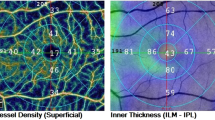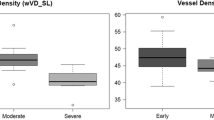Abstract
Purpose
To evaluate vascular microcirculation changes of the optic nerve head (ONH) in the patients with asymmetric pseudoexfoliative glaucoma (XFG) using optical coherence tomography angiography (OCTA) and to compare vessel density (VD) results with healthy individuals.
Methods
This prospective study enrolled 120 eyes in total. The eyes were divided into 3 groups: 40 glaucomatous and 40 non-glaucomatous fellow eyes without clinically pseudoexfoliation material (XFM) of patients with asymmetric XFG, and 40 healthy eyes as controls. The optic disc region was evaluated with OCTA (Optovue, Inc., Fremont, CA). VD was assessed as the ratio of the area formed by the vessels in 3 different regions: (1) inside disc; (2) in the peripapillary area defined as a 1-mm wide elliptical annulus around the disc; and (3) in the whole image defined as a 4-mm wide papillary region.
Results
There were significant decreases in VD values of all regions in XFG eyes compared to fellow and control eyes (p < 0.05 for all comparisons). The mean VD values of peripapillary area and whole image were lower in the non-glaucomatous fellow eyes compared with control eyes (p = 0.011 and p = 0.015, respectively). The receiver operating characteristic analysis for differentiating fellow eyes from healthy eyes had highest area under the curve and sensitivity at 90% specificity for superior-hemi (0.811, 65.2%), followed by ppVD (0.775, 61.8%) and whole image (0.743, 55.9%).
Conclusions
OCTA as a novel imaging may be a valuable structural test in diagnosis and follow-up of glaucoma.


Similar content being viewed by others
References
Plateroti P, Plateroti AM, Abdolrahimzadeh S et al (2015) Pseudoexfoliation syndrome and pseudoexfoliation glaucoma: a review of the literature with updates on surgical management. J Ophthalmol 2015:370371
Ritch R (2018) Ocular findings in exfoliation syndrome. J Glaucoma 27:S67–S71
Ozaki M (2018) Mechanisms of glaucoma in exfoliation syndrome. J Glaucoma 27:S83–S86
Grieshaber MC, Mozaffarieh M, Flammer J (2007) What is the link between vascular dysregulation and glaucoma? Surv Ophthalmol 52:S144–S154
Holló G (2018) Vascular dysfunction in exfoliation syndrome. J Glaucoma 27:S72–S74
Elhawy E, Kamthan G, Dong CQ et al (2012) Pseudoexfoliation syndrome, a systemic disorder with ocular manifestations. Hum Genomics 6:22
Schlötzer-Schrehardt U, Naumann GO (2006) Ocular and systemic pseudoexfoliation syndrome. Am J Ophthalmol 141:921–937
Vardhan SA, Haripriya A, Ratukondla B et al (2017) Association of pseudoexfoliation with systemic vascular diseases in a south Indian population. JAMA Ophthalmol 135:348–354
Chung H, Arora S, Damji KF et al (2018) Association of pseudoexfoliation syndrome with cardiovascular and cerebrovascular disease: a systematic review and meta-analysis. Can J Ophthalmol 53:365–372
Altintaş O, Maral H, Yüksel N et al (2005) Homocysteine and nitric oxide levels in plasma of patients with pseudoexfoliation syndrome, pseudoexfoliation glaucoma, and primary open-angle glaucoma. Graefes Arch Clin Exp Ophthalmol 243:677–683
Yüksel N, Karabaş VL, Arslan A et al (2001) Ocular hemodynamics in pseudoexfoliation syndrome and pseudoexfoliation glaucoma. Ophthalmology 108:1043–1049
Parodi MB, Bondel E, Saviano S et al (2000) Iris indocyanine green angiography in pseudoexfoliation syndrome and capsular glaucoma. Acta Ophthalmol Scand 78:437–442
Ramírez AI, Salazar JJ, de Hoz R et al (2015) Macro- and microglial responses in the fellow eyes contralateral to glaucomatous eyes. Prog Brain Res 220:155–172
Rojas B, Gallego BI, Ramírez AI et al (2014) Microglia in mouse retina contralateral to experimental glaucoma exhibit multiple signs of activation in all retinal layers. J Neuroinflammation 11:133
Gallego BI, Salazar JJ, de Hoz R et al (2012) IOP induces upregulation of GFAP and MHC-II and microglia reactivity in mice retina contralateral to experimental glaucoma. J Neuroinflammation 9:92
de Hoz R, Ramírez AI, González-Martín R et al (2018) Bilateral early activation of retinal microglial cells in a mouse model of unilateral laser-induced experimental ocular hypertension. Exp Eye Res 171:12–29
Spaide RF, Fujimoto JG, Waheed NK et al (2018) Optical coherence tomography angiography. Prog Retin Eye Res 64:1–55
Rebolleda G, Pérez-Sarriegui A, De Juan V et al (2019) A comparison of two optical coherence tomography-angiography devices in pseudoexfoliation glaucoma versus primary open-angle glaucoma and healthy subjects. Eur J Ophthalmol 29:636–644
Park JH, Yoo C, Girard MJA et al (2018) Peripapillary vessel density in glaucomatous eyes: comparison between pseudoexfoliation glaucoma and primary open-angle glaucoma. J Glaucoma 27:1009–1016
Suwan Y, Geyman LS, Fard MA et al (2018) Peripapillary perfused capillary density in exfoliation syndrome and exfoliation glaucoma versus POAG and healthy controls: an OCTA study. Asia Pac J Ophthalmol (Phila) 7:84–89
(2017) European Glaucoma Society Terminology and Guidelines for Glaucoma, 4th Edition – Chapter 2: classification and terminology. Supported by the EGS Foundation. Br J Ophthalmol 101:73–127
Zhang S, Wu C, Liu L et al (2017) Optical coherence tomography angiography of the peripapillary retina in primary angle-closure glaucoma. Am J Ophthalmol 182:194–200
Yip VCH, Wong HT, Yong VKY et al (2019) Optical coherence tomography angiography of optic disc and macula vessel density in glaucoma and healthy eyes. J Glaucoma 28:80–87
De Moraes CG, Liebmann JM, Liebmann CA et al (2013) Visual field progression outcomes in glaucoma subtypes. Acta Ophthalmol 91:288–293
Kim S, Sung KR, Lee JR et al (2013) Evaluation of lamina cribrosa in pseudoexfoliation syndrome using spectral-domain optical coherence tomography enhanced depth imaging. Ophthalmology 120:1798–1803
Atalar PT, Atalar E, Kilic H et al (2006) Impaired systemic endothelial function in patients with pseudoexfoliation syndrome. Int Heart J 47:77–84
Praveen MR, Shah SK, Vasavada AR et al (2011) Pseudoexfoliation as a risk factor for peripheral vascular disease: a case-control study. Eye (Lond) 25:174–179
Wang W, He M, Zhou M et al (2014) Ocular pseudoexfoliation syndrome and vascular disease: a systematic review and meta-analysis. PLoS One 9:e92767
Andrikopoulos GK, Alexopoulos DK, Gartaganis SP (2014) Pseudoexfoliation syndrome and cardiovascular diseases. World J Cardiol 6:847–854
Flammer J, Orgül S, Costa VP et al (2002) The impact of ocular blood flow in glaucoma. Prog Retin Eye Res 21:359–393
Goren Sahin D, Sahin A, Akay OM (2016) Comparison of rotational thromboelastography findings in pseudoexfoliation syndrome patients and healthy controls. J Glaucoma 25:879–882
Tanito M, Kaidzu S, Takai Y et al (2012) Status of systemic oxidative stresses in patients with primary open-angle glaucoma and pseudoexfoliation syndrome. PLoS One 7:e49680
Doudevski I, Rostagno A, Cowman M et al (2014) Clusterin and complement activation in exfoliation glaucoma. Invest Ophthalmol Vis Sci 55:2491–2499
Tetikoğlu M, Sağdik HM, Aktas S et al (2016) Serum prolidase activity and oxidative stress in patients with pseudoexfoliation syndrome. Graefes Arch Clin Exp Ophthalmol 254:1339–1343
Want A, Gillespie SR, Wang Z et al (2016) Autophagy and mitochondrial dysfunction in tenon fibroblasts from exfoliation glaucoma patients. PLoS One 11:e0157404
Mase T, Ishibazawa A, Nagaoka T et al (2016) Radial peripapillary capillary network visualized using wide-field montage optical coherence tomography angiography. Invest Ophthalmol Vis Sci 57:OCT504–OCT510
Mansoori T, Sivaswamy J, Gamalapati JS et al (2017) Radial peripapillary capillary density measurement using optical coherence tomography angiography in early glaucoma. J Glaucoma 26:438–443
Mansoori T, Sivaswamy J, Gamalapati JS et al (2018) Topography and correlation of radial peripapillary capillary density network with retinal nerve fibre layer thickness. Int Ophthalmol 38:967–974
Akil H, Huang AS, Francis BA et al (2017) Retinal vessel density from optical coherence tomography angiography to differentiate early glaucoma, pre-perimetric glaucoma and normal eyes. PLoS One 12:e0170476
Yarmohammadi A, Zangwill LM, Manalastas PIC et al (2018) Peripapillary and macular vessel density in patients with primary open-angle glaucoma and unilateral visual field loss. Ophthalmology 125:578–587
Kozart DM, Yanoff M (1982) Intraocular pressure status in 100 consecutive patients with exfoliation syndrome. Ophthalmology 89:214–218
Arnarsson A, Damji KF, Sverrisson T et al (2007) Pseudoexfoliation in the Reykjavik eye study: prevalence and related ophthalmological variables. Acta Ophthalmol Scand 85:822–827
Puska PM (2002) Unilateral exfoliation syndrome: conversion to bilateral exfoliation and to glaucoma: a prospective 10-year follow-up study. J Glaucoma 11:517–524
Arnarsson A, Sasaki H, Jonasson F (2013) Twelve-year incidence of exfoliation syndrome in the Reykjavik eye study. Acta Ophthalmol 91:157–162
Parekh P, Green WR, Stark WJ et al (2008) Electron microscopic investigation of the lens capsule and conjunctival tissues in individuals with clinically unilateral pseudoexfoliation syndrome. Ophthalmology 115:614–619
Chang R, Nelson AJ, LeTran V et al (2019) Systemic determinants of peripapillary vessel density in healthy African Americans: the African American eye disease study. Am J Ophthalmol 207:240–247
Nelson AJ, Chang R, LeTran V et al (2019) Ocular determinants of peripapillary vessel density in healthy African Americans: the African American eye disease study. Invest Ophthalmol Vis Sci 60:3368–3373
Holló G (2017) Influence of large intraocular pressure reduction on peripapillary OCT vessel density in ocular hypertensive and glaucoma eyes. J Glaucoma 26:e7–e10
Ma ZW, Qiu WH, Zhou DN et al (2019) Changes in vessel density of the patients with narrow antenior chamber after an acute intraocular pressure elevation observed by OCT angiography. BMC Ophthalmol 19:132
Author information
Authors and Affiliations
Contributions
Design of the study (MS, UE); conduct of the study (MS); collection and management of data (MS, AMK, SC, ES, UE); analysis and interpretation of data (MS, ES, UE); writing of manuscript (MS, UE); review or approval of manuscript (AMK, SC, ES).
Corresponding author
Ethics declarations
Conflict of interest
The authors declare that they have no conflict of interest. The authors indicate they have no financial disclosures. The authors, their families, their employers and their business associates have no financial or proprietary interest in any product or company associated with any device, instrument or drug mentioned in this article. The authors have not received any payment as consultants, reviewers or evaluators of any of the devices, instruments or drugs mentioned in this article.
Ethical approval
All procedures performed in studies involving human participants were in accordance with the ethical standards of the Ankara Education and Research Hospital (Report Number: 2019-37) and with the 1964 Helsinki Declaration and its later amendments or comparable ethical standards.
Informed consent
Informed consent was obtained from all individual participants included in the study.
Consent to participate
As the corresponding and first author, I approve on behalf of all the authors in the study.
Consent for publication
As the corresponding and first author, I approve on behalf of all the authors in the study.
Availability of data and material
Not applicable
Code availability
Not applicable
Additional information
Publisher’s note
Springer Nature remains neutral with regard to jurisdictional claims in published maps and institutional affiliations.
Rights and permissions
About this article
Cite this article
Simsek, M., Kocer, A.M., Cevik, S. et al. Evaluation of the optic nerve head vessel density in the patients with asymmetric pseudoexfoliative glaucoma: an OCT angiography study. Graefes Arch Clin Exp Ophthalmol 258, 1493–1501 (2020). https://doi.org/10.1007/s00417-020-04668-x
Received:
Revised:
Accepted:
Published:
Issue Date:
DOI: https://doi.org/10.1007/s00417-020-04668-x




